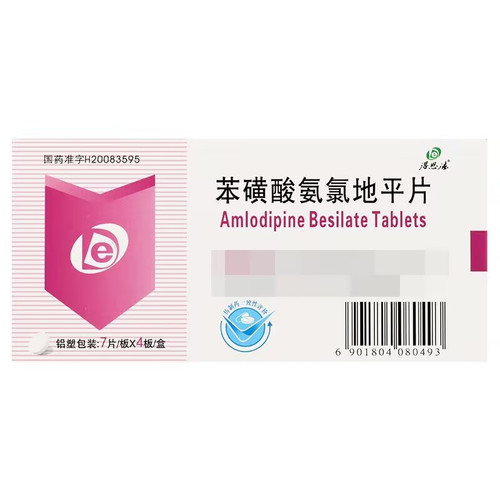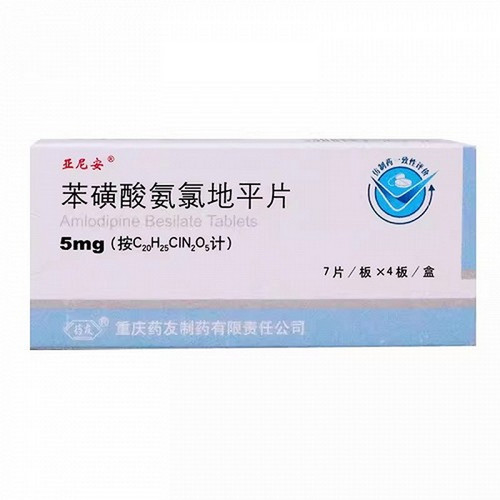Product Overview
[Drug Name]
Generic Name: Amlodipine Besylate Tablets
Trade Name: Dongfangming Amlodipine Besylate Tablets 5mg*28 Tablets
Pinyin Code: DongYao BenHuangSuanAnLvDiPingPian 5mg*28 Tablets
[Main Ingredients]
The main ingredient of this product is amlodipine besylate.
[Properties]
This product is white tablets.
[Indications/Main Functions]
"1. Hypertension: This product is indicated for the treatment of hypertension. It can be used alone or in combination with other antihypertensive drugs. Hypertension control is part of comprehensive cardiovascular risk management, which may include lipid control, diabetes management, antithrombotic therapy, smoking cessation, physical exercise, and sodium restriction. Increases in systolic or diastolic blood pressure increase cardiovascular risk. The absolute risk increase per mmHg increase is greater at higher baseline blood pressure levels. The relative degree of risk reduction achieved by lowering blood pressure is similar among populations with varying absolute cardiovascular risk. In patients with severe hypertension, even a small reduction in blood pressure can provide significant clinical benefit. In adults with hypertension, lowering blood pressure generally reduces the risk of cardiovascular events, primarily stroke and myocardial infarction. 2. Coronary Artery Disease (CAD) Chronic Stable Angina: This product is indicated for the symptomatic treatment of chronic stable angina. It can be used alone or in combination with other antianginal drugs. Vasospastic angina (Prinzmetal's or variant angina) This drug is indicated for the treatment of confirmed or suspected vasospastic angina. It can be used alone or in combination with other anti-anginal drugs. For patients with angiographically confirmed coronary artery disease but an ejection fraction ≥40% and no heart failure, this drug can reduce the risk of hospitalization for angina and the need for coronary revascularization.
[Precautions]
1. Warning: A very small number of patients, especially those with severe obstructive coronary artery disease, may experience increased frequency, prolonged duration, and/or severity of angina, or acute myocardial infarction, when initiating or increasing the dose of calcium channel blockers. The mechanism of action is currently unknown. 2. Because the vasodilatory effect of this drug develops gradually, rare cases of acute hypotension have been reported after taking this drug. However, caution should be exercised when using this drug in combination with other peripheral vasodilators in patients with severe aortic stenosis. 3. Use in Patients with Heart Failure: Calcium channel blockers should be used with caution in patients with congestive heart failure. In a long-term, placebo-controlled study (PRAISE-2) in patients with non-ischemic heart failure (NYHA class III-IV), although the incidence of exacerbations of heart failure was not significantly different from placebo, there was an increase in reports of pulmonary edema associated with amlodipine. 4. Use in Patients with Impaired Hepatic Function: As with all other calcium channel blockers, the half-life of this drug is prolonged in patients with impaired hepatic function, but a corresponding recommended dose has not yet been established. Therefore, caution should be exercised when using this drug. 5. Use in Patients with Renal Failure: Changes in amlodipine plasma concentrations are not correlated with the degree of renal impairment; therefore, a normal dose can be used. This drug should not be dialyzed.
[Drug Interactions]
This drug is contraindicated in patients with hypersensitivity to dihydropyridines or any of the ingredients in this drug.
[Pediatric Use]
This study has not been conducted and no reliable references are available.
[Elderly Use]
This is not yet established.
[Use during Pregnancy and Lactation]
There is a lack of research data on the use of this drug in pregnant women. However, based on animal studies, this product should only be used when absolutely necessary. It is unknown whether this product is excreted in breast milk; lactating women taking this drug should discontinue breastfeeding.
[Specifications]
5mg*28 tablets
[Dosage and Administration]
1. The initial dose for the treatment of hypertension is 5 mg once daily, with a maximum dose of 10 mg once daily. For frail or elderly patients, or those with hepatic insufficiency, the initial dose is 2.5 mg once daily; this dose may also be added to other antihypertensive medications. Dose adjustments should be made based on individual patient response. Generally, dose adjustments should be initiated after 7-14 days. If clinically indicated, dose adjustments may be initiated sooner, after close observation of the patient. 2. The initial dose for the treatment of angina pectoris is 5-10 mg once daily. Lower doses are recommended for elderly patients and those with hepatic insufficiency. The effective dose for most patients is 10 mg/day.
Adverse Reactions: Amlodipine is well tolerated. In placebo-controlled clinical trials for the treatment of hypertension or angina pectoris, the most common side effects were: Autonomic nervous system: flushing; General: fatigue; Cardiovascular, general: edema; Central and peripheral nervous system: dizziness, headache; Gastrointestinal: abdominal pain, nausea; Heart rate/rhythm: palpitations; Psychological: somnolence. No significant clinical laboratory abnormalities related to amlodipine were observed in these clinical trials. Less common side effects observed post-marketing include: Autonomic nervous system: dry mouth, increased sweating Systemic: weakness, back pain, malaise, pain, weight gain/loss Cardiovascular, general: hypotension, syncope Central and peripheral nervous system: hypertonia, hypoesthesia/paresthesia, peripheral neuropathy, tremor Endocrine: breast hyperplasia Gastrointestinal: changes in bowel habits, dyspepsia (including gastritis), gingival hyperplasia, pancreatitis, vomiting Metabolic/nutritional: hyperglycemia Musculoskeletal: arthralgia, muscle cramps, myalgia Platelets/bleeding/coagulation: purpura, thrombocytopenic purpura Psychological: impotence, insomnia, attitude change Respiratory: cough, dyspnea, rhinitis Skin/appendages: hair loss, skin discoloration, urticaria Special senses: taste disturbances, tinnitus Urinary system: frequent urination, dysuria, enuresis Vascular (extracardiac): vasculitis Vision: visual impairment Leukocyte/reticuloendothelial system: leukopenia Hypersensitivity reactions are rare and include pruritus, rash, vasogenic edema, and erythema multiforme. Very rare cases of hepatitis, jaundice, and elevated transaminases (usually consistent with cholestasis) have been reported. Severe cases requiring hospitalization have been reported in association with amlodipine use, but in most cases, a causal relationship has not been established. Similar to other calcium channel blockers, the following adverse events have been reported rarely, but these events are difficult to distinguish from the natural history of the underlying disease: myocardial infarction, arrhythmias (including bradycardia, ventricular tachycardia, and atrial fibrillation), and chest pain.
Contraindications: This product is contraindicated in patients with hypersensitivity to dihydropyridines or any of its components.
Overdose: Available data suggest that severe overdose can cause excessive peripheral vasodilation and may precipitate reflex tachycardia. Significant and prolonged systemic hypotension and fatal shock have been reported. In healthy volunteers, administration of activated charcoal immediately or within 2 hours after taking 10 mg of amlodipine significantly reduced amlodipine absorption. Overdose with this drug may require gastric lavage. If significant hypotension occurs, aggressive cardiovascular support is required, including cardiopulmonary monitoring, limb elevation, and monitoring of circulating fluid and urine output. To restore vascular tone and blood pressure, vasoconstrictors may be used if not contraindicated. Intravenous calcium gluconate is also beneficial for reversing the effects of calcium antagonists. Due to its high plasma protein binding, dialysis is not beneficial.
[Pharmacology and Toxicology]
Pharmacological Action: This drug is a calcium blocker (also known as a slow-channel blocker or calcium antagonist) that blocks the transmembrane entry of calcium ions into myocardial and vascular smooth muscle cells. Its antihypertensive mechanism is direct relaxation of vascular smooth muscle. The exact mechanism by which angina is relieved is not fully understood, but it may dilate peripheral arterioles and coronary arteries, reduce total peripheral vascular resistance, relieve coronary artery spasm, decrease cardiac afterload, and reduce cardiac energy consumption and oxygen demand, thereby relieving angina. The Prospective Randomized Evaluation of Vascular Effects of Amlodipine (NORVASC) Clinical Trial (PREVENT) investigated its effects on cardiovascular morbidity and mortality, progression of coronary atherosclerosis, and carotid atherosclerosis. This multicenter, randomized, double-blind, placebo-controlled study followed 825 patients with angiographically confirmed coronary artery disease for three years. This population included patients with a history of myocardial infarction (45%), prior PTCA (42%), or a history of angina (69%). The severity of CAD ranged from single-vessel disease (45%) to three-vessel disease (21%). Patients with uncontrolled hypertension (DBP > 95 mmHg) were excluded from the study. Major cardiovascular events were adjudicated by a blinded endpoint committee. Although amlodipine has not been shown to slow the progression of coronary artery disease, it can prevent the increase in carotid intima-media thickness. Amlodipine-treated patients experienced a significant reduction (-31%) in the composite endpoint of cardiovascular death, myocardial infarction, stroke, PTCA, coronary artery bypass grafting (CABG), hospitalization for unstable angina, and worsening congestive heart failure (CHF). Revascularization procedures (PTCA and CABG) were also significantly reduced (-42%). Hospitalizations for unstable angina were also reduced compared to placebo (-33%). Toxicity Studies: Genotoxicity studies revealed no drug-related mutagenic effects at either the genetic or chromosomal levels. Reproductive Toxicity: Amlodipine administered to rats (male rats starting 64 days before mating and female rats starting 14 days before mating) at doses up to 10 mg/kg/day (8 times the maximum recommended human dose* on a mg/m² basis) did not affect fertility. Carcinogenicity: Amlodipine was administered to rats and mice at doses of 0.5, 1.25, and 2.5 mg/kg/day, administered by diet, for two years without observed carcinogenicity. The maximum dose (calculated on a mg/m² basis, approximates the maximum recommended human dose (MRD)*10 mg in mice and is twice the MRD*10 mg in rats) is close to the maximum tolerated dose in mice (but not in rats). *The MRD in humans is calculated based on a patient weight of 50 kg.
[Pharmacokinetics]
This drug is well absorbed orally and is not affected by food. Peak plasma concentrations are reached 6-12 hours after administration. The absolute bioavailability is approximately 64-80%, the apparent volume of distribution is approximately 21 L/kg, and the terminal elimination half-life is approximately 35-50 hours. Steady-state plasma concentrations are achieved after 7-8 days of once-daily dosing. This drug is extensively metabolized in the liver to inactive metabolites, excreted in the urine as 10% parent drug and 60% metabolites. Plasma protein binding is approximately 97.5%.






